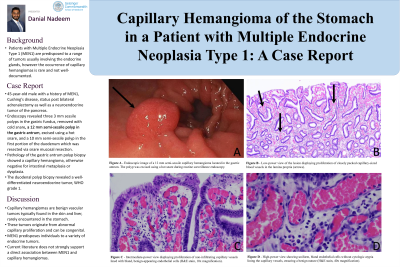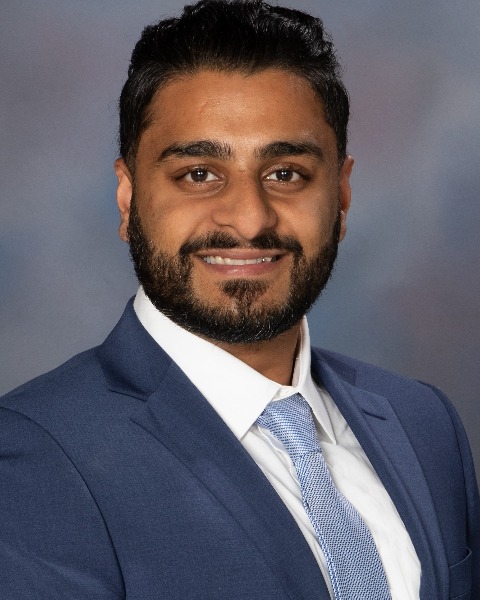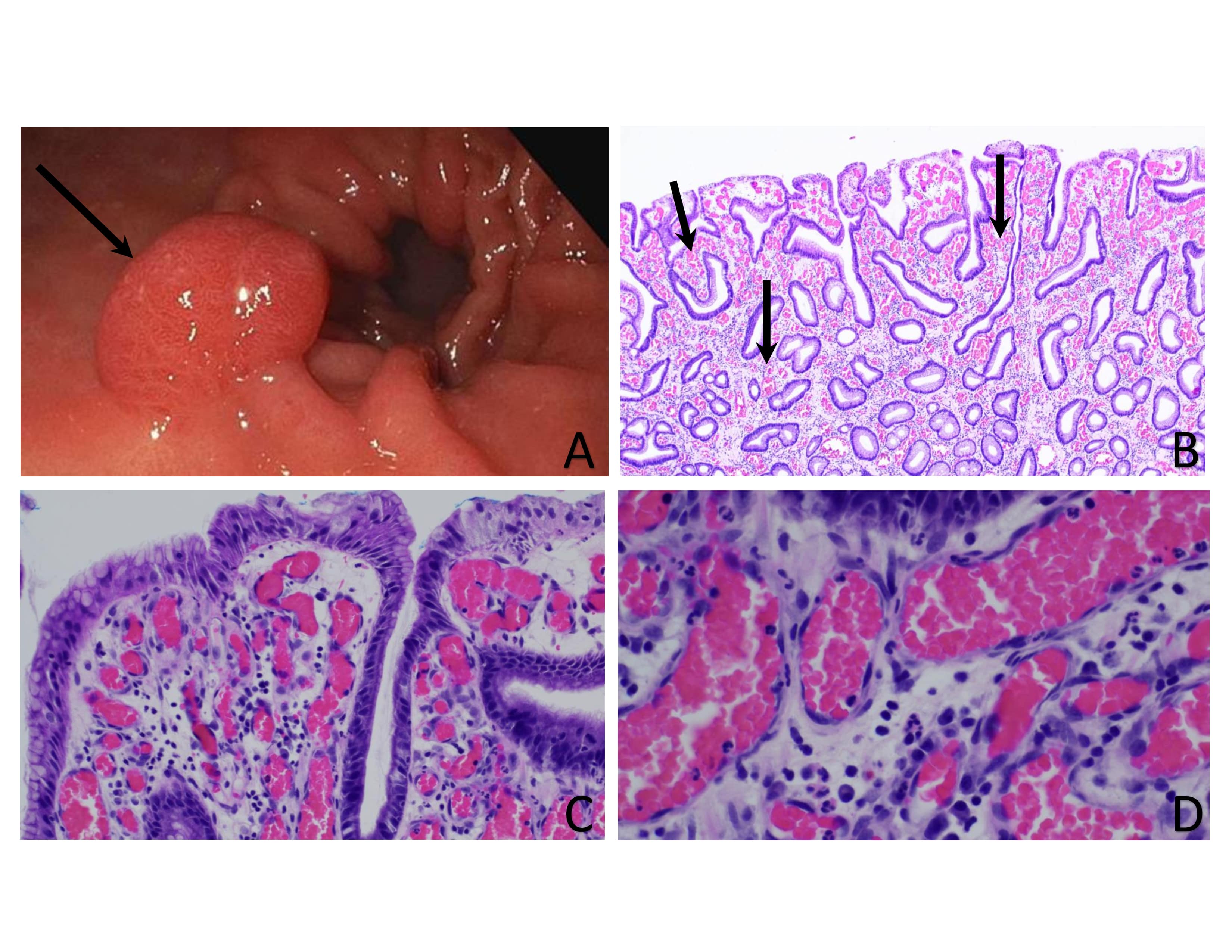Monday Poster Session
Category: Stomach
P3352 - Capillary Hemangioma in the Stomach of a Patient With Multiple Endocrine Neoplasia Type 1: A Case Report
Monday, October 28, 2024
10:30 AM - 4:00 PM ET
Location: Exhibit Hall E

Has Audio

Danial Nadeem, MD
Geisinger Wyoming Valley Medical Center
Wilkes-Barre, PA
Presenting Author(s)
Danial Nadeem, MD1, John Samies, DO2, Jialing Huang, MD3, Yakub Khan, MD1
1Geisinger Wyoming Valley Medical Center, Wilkes-Barre, PA; 2Geisinger Health System, Mountain Top, PA; 3Geisinger Health System, Danville, PA
Introduction: Patients with Multiple Endocrine Neoplasia Type 1 (MEN1) are predisposed to a range of malignancies usually involving the endocrine glands, however the occurrence of capillary hemangiomas (CH) is rare and not well-documented.1,2 This case report presents a patient with MEN1, found to have a gastric CH, highlighting the complexity in managing such patients.
Case Description/Methods: A 45-year-old male with a history of MEN1, Cushing's disease status post bilateral adrenalectomy as well as a neuroendocrine tumor of the pancreas, presented for an outpatient endoscopy. Endoscopy revealed three 3 mm sessile polyps in the gastric fundus, removed with a cold snare, a 12 mm semi-sessile polyp in the gastric antrum, excised using a hot snare, and a 10 mm semi-sessile polyp in the first portion of the duodenum which was resected via snare mucosal resection with one band placed.
Histopathological examination of the gastric fundus revealed gastric fundic gland polyps, negative for H. Pylori, intestinal metaplasia, and dysplasia. The gastric antrum polyp biopsy showed a capillary hemangioma and chronic gastritis, also negative for H. pylori, intestinal metaplasia, and dysplasia. The duodenal polyp biopsy revealed a well-differentiated neuroendocrine tumor, WHO grade 1.
Discussion: CH are benign vascular tumors typically found in the skin and liver, and much less commonly in the stomach. These tumors originate from the abnormal proliferation of capillaries.3 MEN1 predisposes individuals to a variety of endocrine tumors, complicating clinical management. The histopathological findings of fundic gland polyps, an inflammatory polyp, and a neuroendocrine tumor, as seen in our patient reflect the diverse tumor spectrum in MEN1 patients.
Current literature does not support a direct association between MEN1 and CH.2 However, the presence of multiple gastrointestinal polyps, including a gastric capillary hemangioma, suggests thorough and regular surveillance in MEN1 patients may be warranted.
CH has a good prognosis if treated appropriately. Treatment options include monitoring of small, asymptomatic tumors, whereas larger or symptomatic tumors may require endoscopic removal or surgical resection.4 Advanced endoscopic techniques allow for successful polyp removal with minimal complications.
This case contributes to the limited literature on gastric CH and MEN1, demonstrating that endoscopic surveillance and intervention can effectively manage and treat such patients, however, further research is needed.

Disclosures:
Danial Nadeem, MD1, John Samies, DO2, Jialing Huang, MD3, Yakub Khan, MD1. P3352 - Capillary Hemangioma in the Stomach of a Patient With Multiple Endocrine Neoplasia Type 1: A Case Report, ACG 2024 Annual Scientific Meeting Abstracts. Philadelphia, PA: American College of Gastroenterology.
1Geisinger Wyoming Valley Medical Center, Wilkes-Barre, PA; 2Geisinger Health System, Mountain Top, PA; 3Geisinger Health System, Danville, PA
Introduction: Patients with Multiple Endocrine Neoplasia Type 1 (MEN1) are predisposed to a range of malignancies usually involving the endocrine glands, however the occurrence of capillary hemangiomas (CH) is rare and not well-documented.1,2 This case report presents a patient with MEN1, found to have a gastric CH, highlighting the complexity in managing such patients.
Case Description/Methods: A 45-year-old male with a history of MEN1, Cushing's disease status post bilateral adrenalectomy as well as a neuroendocrine tumor of the pancreas, presented for an outpatient endoscopy. Endoscopy revealed three 3 mm sessile polyps in the gastric fundus, removed with a cold snare, a 12 mm semi-sessile polyp in the gastric antrum, excised using a hot snare, and a 10 mm semi-sessile polyp in the first portion of the duodenum which was resected via snare mucosal resection with one band placed.
Histopathological examination of the gastric fundus revealed gastric fundic gland polyps, negative for H. Pylori, intestinal metaplasia, and dysplasia. The gastric antrum polyp biopsy showed a capillary hemangioma and chronic gastritis, also negative for H. pylori, intestinal metaplasia, and dysplasia. The duodenal polyp biopsy revealed a well-differentiated neuroendocrine tumor, WHO grade 1.
Discussion: CH are benign vascular tumors typically found in the skin and liver, and much less commonly in the stomach. These tumors originate from the abnormal proliferation of capillaries.3 MEN1 predisposes individuals to a variety of endocrine tumors, complicating clinical management. The histopathological findings of fundic gland polyps, an inflammatory polyp, and a neuroendocrine tumor, as seen in our patient reflect the diverse tumor spectrum in MEN1 patients.
Current literature does not support a direct association between MEN1 and CH.2 However, the presence of multiple gastrointestinal polyps, including a gastric capillary hemangioma, suggests thorough and regular surveillance in MEN1 patients may be warranted.
CH has a good prognosis if treated appropriately. Treatment options include monitoring of small, asymptomatic tumors, whereas larger or symptomatic tumors may require endoscopic removal or surgical resection.4 Advanced endoscopic techniques allow for successful polyp removal with minimal complications.
This case contributes to the limited literature on gastric CH and MEN1, demonstrating that endoscopic surveillance and intervention can effectively manage and treat such patients, however, further research is needed.

Figure: Figure A - Endoscopic image of a 12 mm semi-sessile capillary hemangioma located in the gastric antrum. The polyp was excised using a hot snare during routine surveillance endoscopy.
Figure B - Low-power view of the lesion displaying proliferation of closely packed capillary-sized blood vessels in the lamina propria (arrows). No aberrant arterial or venous vessels are identified (H&E stain, 4x).
Figure C - Intermediate-power view displaying proliferation of non-infiltrating capillary vessels lined with bland, benign-appearing endothelial cells (H&E stain, 10x magnification).
Figure D - High-power view showing uniform, bland endothelial cells without cytologic atypia lining the capillary vessels, ensuring a benign nature (H&E stain, 40x magnification).
Figure B - Low-power view of the lesion displaying proliferation of closely packed capillary-sized blood vessels in the lamina propria (arrows). No aberrant arterial or venous vessels are identified (H&E stain, 4x).
Figure C - Intermediate-power view displaying proliferation of non-infiltrating capillary vessels lined with bland, benign-appearing endothelial cells (H&E stain, 10x magnification).
Figure D - High-power view showing uniform, bland endothelial cells without cytologic atypia lining the capillary vessels, ensuring a benign nature (H&E stain, 40x magnification).
Disclosures:
Danial Nadeem indicated no relevant financial relationships.
John Samies indicated no relevant financial relationships.
Jialing Huang indicated no relevant financial relationships.
Yakub Khan indicated no relevant financial relationships.
Danial Nadeem, MD1, John Samies, DO2, Jialing Huang, MD3, Yakub Khan, MD1. P3352 - Capillary Hemangioma in the Stomach of a Patient With Multiple Endocrine Neoplasia Type 1: A Case Report, ACG 2024 Annual Scientific Meeting Abstracts. Philadelphia, PA: American College of Gastroenterology.

